BHA Jumps Handicapping Review (2021-22) | Project Update
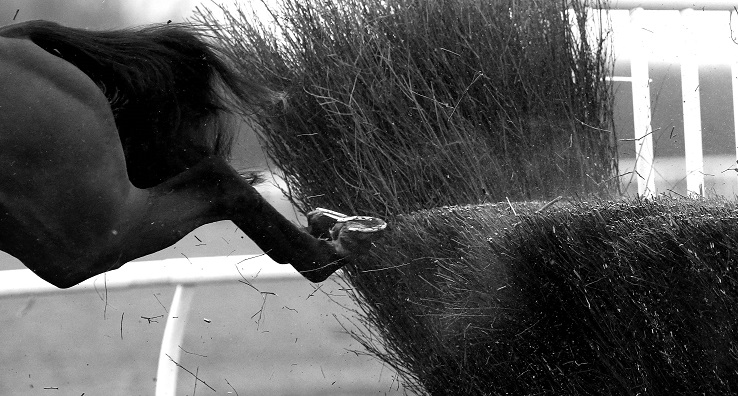
Background
In September of last year (2021) the British Horseracing Authority (BHA) published the recommendations from an internal review of our Jumps Handicapping processes, instigated as a result of our standard post Cheltenham Festival/Aintree reviews. It was a review designed to highlight areas in which we could improve our work and provide a better product for British jumps racing all year round.
One of the main areas of study was to look at the distribution of ratings across both the hurdle and chase files in comparison with the equivalent combined data from the three jumps seasons running from 2008 through to 2011. These three seasons were chosen as they were much closer to the expected distribution of a ratings file whilst also remaining stable and consistent.
It became apparent that there had been a change in distribution within areas of both files (see graphs below) – in short, there had been an upward movement of the horses located in the middle part of the files, causing the “bulge” to move higher up the ratings scale.
In an effort to remedy the situation and return the files to, or somewhere close to the 2008-11 status, we stated that there would be no “seismic” change in handicapping methodology and the basics such as recent form, relativity between horses, profile, success rates etc would continue to underpin our work but the following actions would also be followed:
- More generous drops where appropriate for older/regressive/ non-winning horses
- Start certain sections of the novice hurdle cohort on lower opening marks
- Recalculate BHA Race Standards where appropriate
- Remove horses from the ratings file who haven’t run for 6 months rather than 9 months – thus allowing the handicapper to assess their marks when entered again
- More rigorous back handicapping
We set ourselves a target of January 2022 to try and complete this process, or certainly to make as much progress as possible, with weekly analytical updates to monitor that progress.
In February we published an update as to how the work was progressing and now, nine months later as the new jumps seasons heads into its busiest and most important period, it is time to publish the latest update.
Once again, the key points are:
- Hurdle & Chase File Distribution
- Project Effect Statistics
- Conclusion
Hurdle & Chase File Distribution
The graphs below clearly outline the issue – the green lines representing the distribution of the files through the combined 2008-2011 seasons, the blue lines representing the final distribution at the conclusion of the 2020-21 season and the red lines representing the position of the post-review files as of October 31st this year.
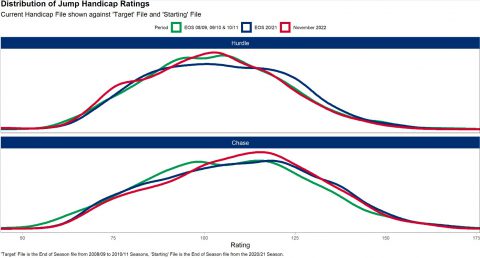
The hurdle file had met its target by the January 2022 deadline and it clear to see from the positions of the green and red lines that the desired position has subsequently been maintained.
As reported in February the chase file has been slower to move but it can be seen that progress is now being made with the red line (current file position) now undercutting the blue line that represents the end of 20/21 campaign and slowing edging towards the target green line in the 135-150 area.
As originally highlighted in the first review paper in February, the slow progress of the chase file to make the required movement continues to be the small field sizes – as we progress into the main period of the jumps season and with ground conditions easing, hopefully larger field sizes will help address this.
With the hurdle file now operating at a lower level, the chase file should also see movement when those ratings are transferred across.
Project Effect Statistics
For purposes of comparison, “Pre Review” is a combination of the four jumps seasons 2017-21 whilst “Post Review” is from the start of the 2021-22 season through to October 31st 2022.
Percentage of Runners by Individual Rating Drop
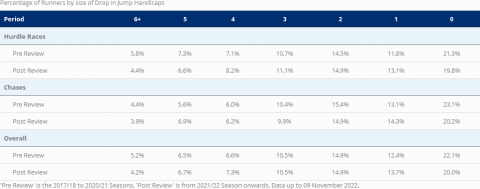
The most striking feature is the fact that fewer runners are being left unchanged both over hurdles (1.4% less) and fences (2.9% less) after a run in a handicap. The hurdle file shows an increased number of horses being dropped by 1,2,3 and 4lb and whilst the chase file isn’t quite so consistent in that area, it is likely the small field sizes during the summer impacted that area and hopefully increased numbers during the winter months will see more future movement.
Percentage of Runners being Dropped

Average Rating Change for Horses Winners and Placed 2nd, 3rd & 4th in a Handicap
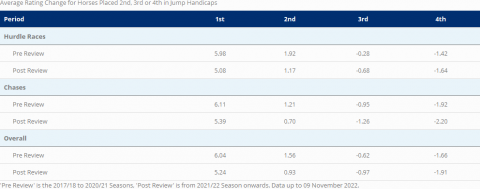
Highlights the slightly different approach to the treatment of horses that have run well. Winners of both hurdle (-0.88lb) and chase (-0.72lb) handicaps are being raised less on average, runners up are also being raised less (hurdle = -0.74lb, chase = -0.51lb) and the placed horses are being dropped more.
Opening Handicap Marks of Hurdlers

Clear to see that the aim to start certain areas of the novice hurdle cohort on lower opening marks has been met.
GB v IRE in GB Handicaps
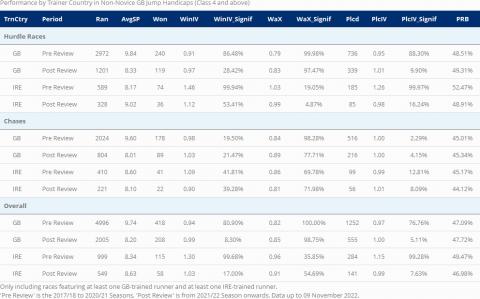
Lots of headings across the top of this table – relevant ones for the purposes of this update are:
Ran = number of runners
Won = number of winners
WinIV = win Impact Value
Placd = number of placed horses
PlcIV = placed Impact Value
PRB = percentage of runners beaten
I have stressed from the beginning of this process that the aim was never to be “anti-Irish” – there were problems that existed in the jumps files that needed addressing to improve our day- to-day product. One of the potential by-products of the review was to give a more balanced look to the comparative performances of GB and Irish trained horses in handicaps in which both countries had runners, particularly over hurdles.
Given that Irish trained horses have only been allowed to compete in Class 4 and above handicaps since the start of the review, figures for the pre-review seasons of 2017-21 cover the same class of races to ensure like for like comparison.
The aim to achieve a greater degree of parity has largely been achieved.
Post review figures show the respective win Impact Values (1.00 being the aim) over hurdles to be 0.97 (GB – up from 0.91) and 1.11 (IRE – down from 1.46), whilst the respective strike rates also show greater parity with GB trained runners standing at 9.87% (+1.8%) and Irish trained runners at 10.80% (-1.76%).
There was never quite the same gap between the IVs in handicap chases but in terms of strike rates – GB at 11.11% (+2.32%) and Ireland at 10.05% (+0.05%) – the figures are more comparable post-review.
The combined hurdle/chase win IVs post review also make pleasing reading with GB currently 0.99 (+0.05) and Ireland currently 1.02 (-0.28), whilst overall strike rates have also evened up post review – GB at 10.37% (+2.00%) and Ireland at 10.50% (-1.01%).
Conclusion
The analysis above highlights the fact that the work done under the jumps review is having the desired effect particularly in terms of the distribution of ratings across the files, the number of horses being dropped and the increased parity between GB and Irish trained runners in handicaps.
It remains however, a work in progress and the handicapping team will not be sitting back and taking the view that it is “job done”.
The chase file, in particular, has been a source of frustration although a number of the metrics are encouraging. Small field sizes have once again hampered progress in this area but hopefully that situation should improve as the winter progresses, whilst the process of bringing horses onto the chase file with their hurdle mark (now lower than pre-review) should also help the situation.
There are still areas in which work needs to be done whilst, at the same time, maintaining the levels achieved through the work of the review. This will continue to be done on a short term basis by weekly file analysis and longer term through both file and results analysis.
In short, we will continue to attempt to improve the handicapping product we provide for British jumps racing.
